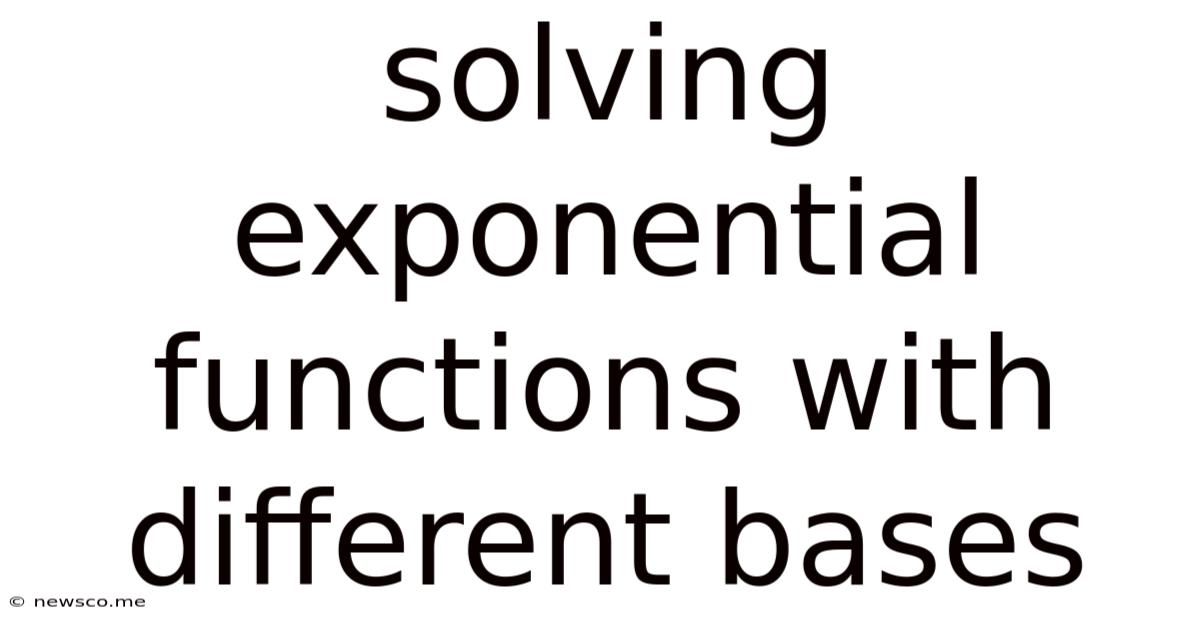Solving Exponential Functions With Different Bases
News Co
May 07, 2025 · 5 min read

Table of Contents
Solving Exponential Functions with Different Bases: A Comprehensive Guide
Solving exponential functions, especially those with different bases, can seem daunting at first. However, with a systematic approach and a solid understanding of logarithmic properties, you can master this skill. This comprehensive guide will walk you through various techniques, providing clear explanations and practical examples to help you confidently tackle any exponential equation.
Understanding Exponential Functions
Before diving into solving equations, let's refresh our understanding of exponential functions. An exponential function is a function of the form:
f(x) = a<sup>x</sup>
where:
- a is the base, a positive constant (a ≠ 1).
- x is the exponent, the independent variable.
The base determines the rate of growth or decay. If a > 1, the function represents exponential growth; if 0 < a < 1, it represents exponential decay. The core of solving exponential equations lies in manipulating these functions to isolate the variable.
Methods for Solving Exponential Equations with Different Bases
Several methods exist for solving exponential equations with different bases. The most common approaches include:
1. Equating Bases
This method is applicable when you can rewrite the equation so that both sides have the same base. This allows you to equate the exponents and solve for the variable.
Example:
Solve 2<sup>x</sup> = 8
Solution:
Since 8 can be expressed as 2<sup>3</sup>, we can rewrite the equation as:
2<sup>x</sup> = 2<sup>3</sup>
Because the bases are equal, we can equate the exponents:
x = 3
This is the simplest scenario. However, it requires careful observation and the ability to recognize equivalent exponential expressions.
2. Using Logarithms
When equating bases isn't feasible, logarithms provide a powerful tool. Logarithms are the inverse functions of exponentials. The key property we'll use is the power rule of logarithms:
log<sub>b</sub>(a<sup>x</sup>) = x * log<sub>b</sub>(a)
This allows us to bring the exponent down as a coefficient. We often use base-10 logarithms (log) or natural logarithms (ln, base e).
Example:
Solve 3<sup>x</sup> = 10
Solution:
Take the logarithm of both sides (using either base-10 or natural logarithms):
log(3<sup>x</sup>) = log(10)
Applying the power rule:
x * log(3) = log(10)
Solve for x:
x = log(10) / log(3)
Using a calculator, we find:
x ≈ 2.0959
This approach works for any exponential equation regardless of whether the bases can be easily equated.
3. Change of Base Formula
The change of base formula allows you to convert a logarithm from one base to another. This is particularly useful when dealing with less common bases or when using calculators that only have base-10 or natural logarithm functions. The formula is:
log<sub>b</sub>(a) = log<sub>c</sub>(a) / log<sub>c</sub>(b)
where 'c' is any valid base.
Example:
Solve 5<sup>x</sup> = 2<sup>x+1</sup>
Solution:
Take the natural logarithm of both sides:
ln(5<sup>x</sup>) = ln(2<sup>x+1</sup>)
Apply the power rule:
x * ln(5) = (x+1) * ln(2)
Expand and solve for x:
x * ln(5) = x * ln(2) + ln(2)
x * (ln(5) - ln(2)) = ln(2)
x = ln(2) / (ln(5) - ln(2))
Using a calculator:
x ≈ 0.76
4. Graphical Methods
For more complex equations or those involving multiple exponential terms, graphical methods can be very helpful. You can graph both sides of the equation as separate functions and find the x-coordinate of their intersection point. This point represents the solution to the equation. This method is particularly useful when algebraic solutions are difficult or impossible to obtain.
Advanced Techniques and Considerations
Solving Exponential Inequalities
The techniques for solving exponential equations can be extended to solve exponential inequalities. Remember to consider the behavior of the exponential function (increasing or decreasing) when determining the solution set.
Example:
Solve 2<sup>x</sup> > 8
Solution:
Since 8 = 2<sup>3</sup>, the inequality becomes:
2<sup>x</sup> > 2<sup>3</sup>
Because the base (2) is greater than 1, the function is increasing. Therefore, we can directly compare the exponents:
x > 3
Systems of Exponential Equations
Sometimes you'll encounter systems of equations involving multiple exponential functions. These can be solved using substitution, elimination, or graphical methods, often in combination with logarithmic techniques.
Handling Exponential Equations with Non-integer Solutions
Many exponential equations will result in non-integer solutions. Always use a calculator to obtain numerical approximations for these solutions, ensuring you round to an appropriate number of significant figures based on the context of the problem.
Practical Applications of Solving Exponential Functions
Solving exponential functions is crucial in various fields, including:
- Finance: Calculating compound interest, loan repayments, and investment growth.
- Biology: Modeling population growth and decay, radioactive decay.
- Physics: Describing radioactive decay, exponential cooling.
- Chemistry: Studying reaction rates, chemical kinetics.
- Computer Science: Analyzing algorithm efficiency, data growth.
Conclusion
Mastering the techniques for solving exponential functions with different bases is a valuable skill with wide-ranging applications. This guide has covered various methods, from the simple equating of bases to more advanced logarithmic and graphical techniques. By understanding the underlying principles and practicing these methods, you'll be well-equipped to tackle a variety of exponential equations and confidently apply this knowledge to real-world problems. Remember to always check your solutions and consider the context of the problem to ensure the reasonableness of your answers. Consistent practice and a clear understanding of logarithmic properties are key to achieving proficiency in this important mathematical area.
Latest Posts
Related Post
Thank you for visiting our website which covers about Solving Exponential Functions With Different Bases . We hope the information provided has been useful to you. Feel free to contact us if you have any questions or need further assistance. See you next time and don't miss to bookmark.